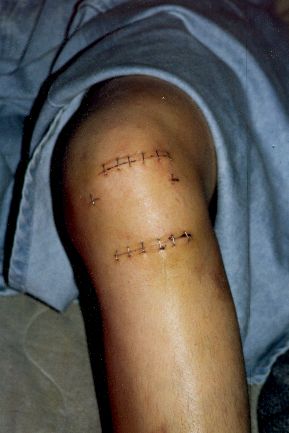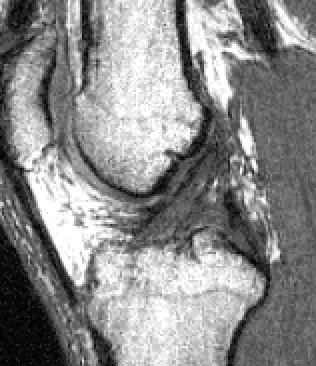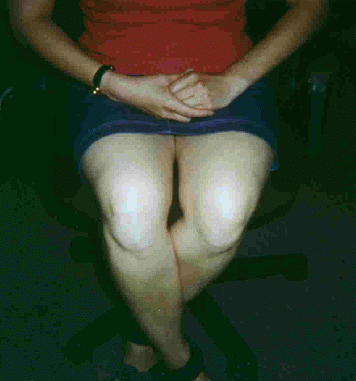
Go to right knee 1997

My left knee injured on January 12th 1996, when I tried to make a piruett-jump in circuit training. When the foot touched the floor, the knee was rotated and I felt a snap followed by flash-like pain. Afterwards walking was more or less painful, and the knee was liable to give away.
The knee was operated in Diakonissalaitos hospital, Helsinki, on March
13th using arthroscopy. The delay was due to inadequate diagnosis in health
center, but actually the surgeon said the best time for operation is about
8 weeks after the injury, when the tissues have calmed down, and so the
timing was quite perfect. Reconstruction operation was made by doctor Syvähuoko
while I was deeply asleep. The anterior crucial ligament (ACL) was completely
torn, and the waste system of my body had eaten it away. There was also
a small rupture in the knee disk (meniscus).

A 8 cm long and 9 mm thick strip of my own patella tendon with small
pieces of bone in both ends was installed to replace the broken ligament.
In
the coloured X-ray pictures you can see the screws made of titanium mixture
which are used to fasten the new ligament. I will carry those screws
in my knee the rest of my life. They do not beep in airports etc. The patella
tendon, which lost about one third of its thickness, will gradually grow
to about 90 % of it's original thickness. The rupture in the knee disc
was also smoothened. The X-ray picture and photo
show also the metal stitches closing the incisions.
When I woke up in the recovery room my leg was installed to a machine,
which straightened and bent the knee slowly back and forth. You were not
allowed to leave the hospital before the bending angle reached 90 degrees
without making you grimace. Only in the recovery room I felt some pain,
but it disappeared after additional medication, and did not come back.
In spend one night in hospital.
I was on crutches for 7 days, and did not use any immobilizer.
From the first day I was told to do series of exercises to mobilize the
knee and maintain muscle strength. Two weeks after operation I stopped
eating pain medication and started training supervised by physiotherapist.
Sick leave lasted one month.

During first months training included water jogging and gym six days a week, a little more than one hour per day. The knee did not like immobility, in the mornings it took time to start it up before I was able to walk normally. While sitting , it was better take a walk every 20 minutes to avoid stiffness.
After three months the training consisted mainly of biking 45-90 minutes a day, plus gym and water jogging twice a week. The full flexion of the knee was achieved about 3.5 months after the operation. Climbing stairs down required extra concentration for months, going up was much easier. Slippery roads postponed the starting of running until March. About a year after the operation I was able to run normally.
Right knee 1997:
Go to left knee 1996

 The
coloured picture with aroows are magnetic resonance images of my right knee taken by Medimagneetti
Ltd. The red arrows show the places where a dark, continuous ACL (like
in black and white reference image) should be. The green arrow points to
my undamaged posterior crucial ligament, which is seen as a dark band.
The
coloured picture with aroows are magnetic resonance images of my right knee taken by Medimagneetti
Ltd. The red arrows show the places where a dark, continuous ACL (like
in black and white reference image) should be. The green arrow points to
my undamaged posterior crucial ligament, which is seen as a dark band.

I started orienteering on 11th of April and successfully run through six competitions and training routes. On May 8th I was taking part into a competition at Lohja. It had been raining in the morning, and there were slippery branches on the ground in one downhill. I stepped on one of those branches with my right leg, slipped, maybe unconsciously tried to save the operate left knee, fell and heard the familiar snap again. Immediately I realized that something quite nasty has happened. I managed to get out of the forest to the first aid although the knee was unstable and in pain. X-ray pictures were taken at health center the same day to ensure that no bones were broken.
The day after I visited doctor Syvähuoko who suspected damages in ACL and medial collateral ligament (MCL). The magnetic resonance images confirmed that ACL was almost completely torn and there may also be a rupture in MCL and joint capsule. Due to suspected MCL and capsule problems the operation was scheduled for May 14th. If MCL and capsule would have be badly damaged, the ACL reconstruction wouldhave occurred only in second operation after some months. The arthroscopy however showed that other injuries were minor, and ACL was reconstructed immediately.

This time I used an immobilizer for a month due to pain in strained MCL. Rehabilitation started right after the stitches were taken away on May 26th.
The X-ray pictures show this time besides the stitches and the screws, the pipe by which liquid is drained away from the operated knee for about 24 hours after the operation.
About a year after the second operation I was able to run properly.
The knee suffered quite a while from slight extension problems, which
were somewhat painful in the beginning of the rehab.
This was due to the fact that the operation was made straight
after the injury,
and the pulled MCL.
Two years after the second operation occasional over
extension when running
on an uneven surface like forest give me a weird feeling around
the patella of the right knee.
Kneeling on hard surfaces causes some discomfort.
These problems are minor, in general both of my knees work
perfectly well.
 This picture shows how my knees look like about 2 years after
the second operation: the scars are quite unnoticeable from normal
viewing distances.
This picture shows how my knees look like about 2 years after
the second operation: the scars are quite unnoticeable from normal
viewing distances.
Next link gives you more links:
Google search of the topic